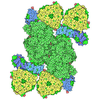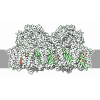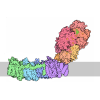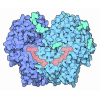+ Open data
Open data
- Basic information
Basic information
| Entry | Database: PDB / ID: 5zgb | ||||||||||||||||||||||||||||||||||||||||||||||||||||||
|---|---|---|---|---|---|---|---|---|---|---|---|---|---|---|---|---|---|---|---|---|---|---|---|---|---|---|---|---|---|---|---|---|---|---|---|---|---|---|---|---|---|---|---|---|---|---|---|---|---|---|---|---|---|---|---|
| Title | Cryo-EM structure of the red algal PSI-LHCR | ||||||||||||||||||||||||||||||||||||||||||||||||||||||
 Components Components |
| ||||||||||||||||||||||||||||||||||||||||||||||||||||||
 Keywords Keywords | PHOTOSYNTHESIS / super-complex / red alga / PSI-5Lhcr | ||||||||||||||||||||||||||||||||||||||||||||||||||||||
| Function / homology |  Function and homology information Function and homology informationplastid thylakoid membrane / thylakoid membrane / photosynthesis, light harvesting / photosystem I reaction center / photosystem I / photosynthetic electron transport in photosystem I / photosystem I / chlorophyll binding / chloroplast thylakoid membrane / photosynthesis ...plastid thylakoid membrane / thylakoid membrane / photosynthesis, light harvesting / photosystem I reaction center / photosystem I / photosynthetic electron transport in photosystem I / photosystem I / chlorophyll binding / chloroplast thylakoid membrane / photosynthesis / chloroplast / 4 iron, 4 sulfur cluster binding / electron transfer activity / oxidoreductase activity / magnesium ion binding / metal ion binding / membrane Similarity search - Function | ||||||||||||||||||||||||||||||||||||||||||||||||||||||
| Biological species |  Cyanidioschyzon merolae (eukaryote) Cyanidioschyzon merolae (eukaryote) Cyanidioschyzon merolae strain 10D (eukaryote) Cyanidioschyzon merolae strain 10D (eukaryote) | ||||||||||||||||||||||||||||||||||||||||||||||||||||||
| Method | ELECTRON MICROSCOPY / single particle reconstruction / cryo EM / Resolution: 3.63 Å | ||||||||||||||||||||||||||||||||||||||||||||||||||||||
 Authors Authors | Pi, X. | ||||||||||||||||||||||||||||||||||||||||||||||||||||||
 Citation Citation |  Journal: Proc Natl Acad Sci U S A / Year: 2018 Journal: Proc Natl Acad Sci U S A / Year: 2018Title: Unique organization of photosystem I-light-harvesting supercomplex revealed by cryo-EM from a red alga. Authors: Xiong Pi / Lirong Tian / Huai-En Dai / Xiaochun Qin / Lingpeng Cheng / Tingyun Kuang / Sen-Fang Sui / Jian-Ren Shen /   Abstract: Photosystem I (PSI) is one of the two photosystems present in oxygenic photosynthetic organisms and functions to harvest and convert light energy into chemical energy in photosynthesis. In eukaryotic ...Photosystem I (PSI) is one of the two photosystems present in oxygenic photosynthetic organisms and functions to harvest and convert light energy into chemical energy in photosynthesis. In eukaryotic algae and higher plants, PSI consists of a core surrounded by variable species and numbers of light-harvesting complex (LHC)I proteins, forming a PSI-LHCI supercomplex. Here, we report cryo-EM structures of PSI-LHCR from the red alga in two forms, one with three Lhcr subunits attached to the side, similar to that of higher plants, and the other with two additional Lhcr subunits attached to the opposite side, indicating an ancient form of PSI-LHCI. Furthermore, the red algal PSI core showed features of both cyanobacterial and higher plant PSI, suggesting an intermediate type during evolution from prokaryotes to eukaryotes. The structure of PsaO, existing in eukaryotic organisms, was identified in the PSI core and binds three chlorophylls and may be important in harvesting energy and in mediating energy transfer from LHCII to the PSI core under state-2 conditions. Individual attaching sites of LHCRs with the core subunits were identified, and each Lhcr was found to contain 11 to 13 chlorophylls and 5 zeaxanthins, which are apparently different from those of LHCs in plant PSI-LHCI. Together, our results reveal unique energy transfer pathways different from those of higher plant PSI-LHCI, its adaptation to the changing environment, and the possible changes of PSI-LHCI during evolution from prokaryotes to eukaryotes. | ||||||||||||||||||||||||||||||||||||||||||||||||||||||
| History |
|
- Structure visualization
Structure visualization
| Movie |
 Movie viewer Movie viewer |
|---|---|
| Structure viewer | Molecule:  Molmil Molmil Jmol/JSmol Jmol/JSmol |
- Downloads & links
Downloads & links
- Download
Download
| PDBx/mmCIF format |  5zgb.cif.gz 5zgb.cif.gz | 773.8 KB | Display |  PDBx/mmCIF format PDBx/mmCIF format |
|---|---|---|---|---|
| PDB format |  pdb5zgb.ent.gz pdb5zgb.ent.gz | 684.1 KB | Display |  PDB format PDB format |
| PDBx/mmJSON format |  5zgb.json.gz 5zgb.json.gz | Tree view |  PDBx/mmJSON format PDBx/mmJSON format | |
| Others |  Other downloads Other downloads |
-Validation report
| Summary document |  5zgb_validation.pdf.gz 5zgb_validation.pdf.gz | 11.7 MB | Display |  wwPDB validaton report wwPDB validaton report |
|---|---|---|---|---|
| Full document |  5zgb_full_validation.pdf.gz 5zgb_full_validation.pdf.gz | 12.3 MB | Display | |
| Data in XML |  5zgb_validation.xml.gz 5zgb_validation.xml.gz | 205.5 KB | Display | |
| Data in CIF |  5zgb_validation.cif.gz 5zgb_validation.cif.gz | 250.6 KB | Display | |
| Arichive directory |  https://data.pdbj.org/pub/pdb/validation_reports/zg/5zgb https://data.pdbj.org/pub/pdb/validation_reports/zg/5zgb ftp://data.pdbj.org/pub/pdb/validation_reports/zg/5zgb ftp://data.pdbj.org/pub/pdb/validation_reports/zg/5zgb | HTTPS FTP |
-Related structure data
| Related structure data |  6929MC  6930C  5zghC M: map data used to model this data C: citing same article ( |
|---|---|
| Similar structure data |
- Links
Links
- Assembly
Assembly
| Deposited unit | 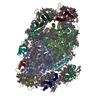
|
|---|---|
| 1 |
|
- Components
Components
-Protein , 12 types, 14 molecules ABCDEFKLO14253
| #1: Protein | Mass: 82763.461 Da / Num. of mol.: 1 / Source method: isolated from a natural source Source: (natural)  Cyanidioschyzon merolae (strain 10D) (eukaryote) Cyanidioschyzon merolae (strain 10D) (eukaryote)Strain: 10D / References: UniProt: Q85FY7, photosystem I | ||||
|---|---|---|---|---|---|
| #2: Protein | Mass: 82107.852 Da / Num. of mol.: 1 / Source method: isolated from a natural source Source: (natural)  Cyanidioschyzon merolae (strain 10D) (eukaryote) Cyanidioschyzon merolae (strain 10D) (eukaryote)Strain: 10D / References: UniProt: Q85FY6, photosystem I | ||||
| #3: Protein | Mass: 8822.272 Da / Num. of mol.: 1 / Source method: isolated from a natural source Source: (natural)  Cyanidioschyzon merolae (strain 10D) (eukaryote) Cyanidioschyzon merolae (strain 10D) (eukaryote)Strain: 10D / References: UniProt: Q85G47, photosystem I | ||||
| #4: Protein | Mass: 15698.932 Da / Num. of mol.: 1 / Source method: isolated from a natural source Source: (natural)  Cyanidioschyzon merolae (strain 10D) (eukaryote) Cyanidioschyzon merolae (strain 10D) (eukaryote)Strain: 10D / References: UniProt: Q85FY0 | ||||
| #5: Protein | Mass: 10545.162 Da / Num. of mol.: 1 / Source method: isolated from a natural source Source: (natural)  Cyanidioschyzon merolae (strain 10D) (eukaryote) Cyanidioschyzon merolae (strain 10D) (eukaryote)Strain: 10D / References: UniProt: Q85FZ1 | ||||
| #6: Protein | Mass: 21239.318 Da / Num. of mol.: 1 / Source method: isolated from a natural source Source: (natural)  Cyanidioschyzon merolae (strain 10D) (eukaryote) Cyanidioschyzon merolae (strain 10D) (eukaryote)Strain: 10D / References: UniProt: Q85FS9 | ||||
| #9: Protein | Mass: 6295.657 Da / Num. of mol.: 1 / Source method: isolated from a natural source Source: (natural)  Cyanidioschyzon merolae (strain 10D) (eukaryote) Cyanidioschyzon merolae (strain 10D) (eukaryote)Strain: 10D / References: UniProt: Q85G51 | ||||
| #10: Protein | Mass: 15157.522 Da / Num. of mol.: 1 / Source method: isolated from a natural source Source: (natural)  Cyanidioschyzon merolae (strain 10D) (eukaryote) Cyanidioschyzon merolae (strain 10D) (eukaryote)Strain: 10D / References: UniProt: Q85FP8 | ||||
| #12: Protein | Mass: 16744.471 Da / Num. of mol.: 1 / Source method: isolated from a natural source Source: (natural)  Cyanidioschyzon merolae (strain 10D) (eukaryote) Cyanidioschyzon merolae (strain 10D) (eukaryote)Strain: 10D / References: UniProt: M1VFJ4 | ||||
| #13: Protein | Mass: 19808.818 Da / Num. of mol.: 2 / Source method: isolated from a natural source Source: (natural)  Cyanidioschyzon merolae (strain 10D) (eukaryote) Cyanidioschyzon merolae (strain 10D) (eukaryote)Strain: 10D / References: UniProt: M1VKK5 #14: Protein | Mass: 21960.398 Da / Num. of mol.: 2 / Source method: isolated from a natural source Source: (natural)  Cyanidioschyzon merolae (strain 10D) (eukaryote) Cyanidioschyzon merolae (strain 10D) (eukaryote)Strain: 10D / References: UniProt: M1UU36 #15: Protein | | Mass: 20458.535 Da / Num. of mol.: 1 / Source method: isolated from a natural source Source: (natural)  Cyanidioschyzon merolae strain 10D (eukaryote) Cyanidioschyzon merolae strain 10D (eukaryote)Strain: 10D |
-Protein/peptide , 3 types, 3 molecules IJM
| #7: Protein/peptide | Mass: 3408.184 Da / Num. of mol.: 1 / Source method: isolated from a natural source Source: (natural)  Cyanidioschyzon merolae (strain 10D) (eukaryote) Cyanidioschyzon merolae (strain 10D) (eukaryote)Strain: 10D / References: UniProt: Q85FQ6 |
|---|---|
| #8: Protein/peptide | Mass: 4410.245 Da / Num. of mol.: 1 / Source method: isolated from a natural source Source: (natural)  Cyanidioschyzon merolae (strain 10D) (eukaryote) Cyanidioschyzon merolae (strain 10D) (eukaryote)Strain: 10D / References: UniProt: Q85FS8 |
| #11: Protein/peptide | Mass: 3139.878 Da / Num. of mol.: 1 / Source method: isolated from a natural source Source: (natural)  Cyanidioschyzon merolae (strain 10D) (eukaryote) Cyanidioschyzon merolae (strain 10D) (eukaryote)Strain: 10D / References: UniProt: Q85G73 |
-Sugars , 2 types, 2 molecules 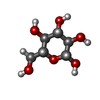
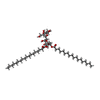

| #22: Sugar | ChemComp-BGC / |
|---|---|
| #23: Sugar | ChemComp-DGD / |
-Non-polymers , 9 types, 213 molecules 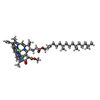
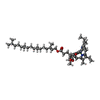
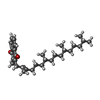
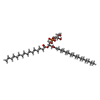
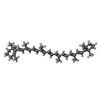
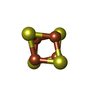
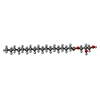










| #16: Chemical | ChemComp-CL0 / | ||||||||||||||
|---|---|---|---|---|---|---|---|---|---|---|---|---|---|---|---|
| #17: Chemical | ChemComp-CLA / #18: Chemical | #19: Chemical | #20: Chemical | ChemComp-BCR / #21: Chemical | #24: Chemical | ChemComp-3XQ / ( | #25: Chemical | ChemComp-ZEX / ( #26: Chemical | ChemComp-1DO / | |
-Details
| Has protein modification | Y |
|---|
-Experimental details
-Experiment
| Experiment | Method: ELECTRON MICROSCOPY |
|---|---|
| EM experiment | Aggregation state: PARTICLE / 3D reconstruction method: single particle reconstruction |
- Sample preparation
Sample preparation
| Component | Name: PSI-5Lhcr / Type: COMPLEX / Entity ID: #1-#15 / Source: NATURAL |
|---|---|
| Source (natural) | Organism:  Cyanidioschyzon merolae (eukaryote) Cyanidioschyzon merolae (eukaryote) |
| Buffer solution | pH: 7.4 |
| Specimen | Conc.: 3 mg/ml / Embedding applied: NO / Shadowing applied: NO / Staining applied: NO / Vitrification applied: YES |
| Vitrification | Cryogen name: NITROGEN / Humidity: 100 % |
- Electron microscopy imaging
Electron microscopy imaging
| Experimental equipment |  Model: Titan Krios / Image courtesy: FEI Company |
|---|---|
| Microscopy | Model: FEI TITAN KRIOS |
| Electron gun | Electron source:  FIELD EMISSION GUN / Accelerating voltage: 300 kV / Illumination mode: FLOOD BEAM FIELD EMISSION GUN / Accelerating voltage: 300 kV / Illumination mode: FLOOD BEAM |
| Electron lens | Mode: BRIGHT FIELD |
| Image recording | Electron dose: 2.17 e/Å2 / Film or detector model: FEI FALCON II (4k x 4k) |
- Processing
Processing
| Software | Name: PHENIX / Version: 1.11.1_2575: / Classification: refinement | ||||||||||||||||||||||||
|---|---|---|---|---|---|---|---|---|---|---|---|---|---|---|---|---|---|---|---|---|---|---|---|---|---|
| EM software |
| ||||||||||||||||||||||||
| CTF correction | Type: NONE | ||||||||||||||||||||||||
| Symmetry | Point symmetry: C1 (asymmetric) | ||||||||||||||||||||||||
| 3D reconstruction | Resolution: 3.63 Å / Resolution method: FSC 0.143 CUT-OFF / Num. of particles: 124279 / Symmetry type: POINT | ||||||||||||||||||||||||
| Refine LS restraints |
|
 Movie
Movie Controller
Controller





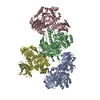
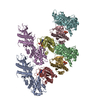

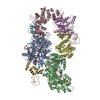
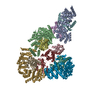

 PDBj
PDBj